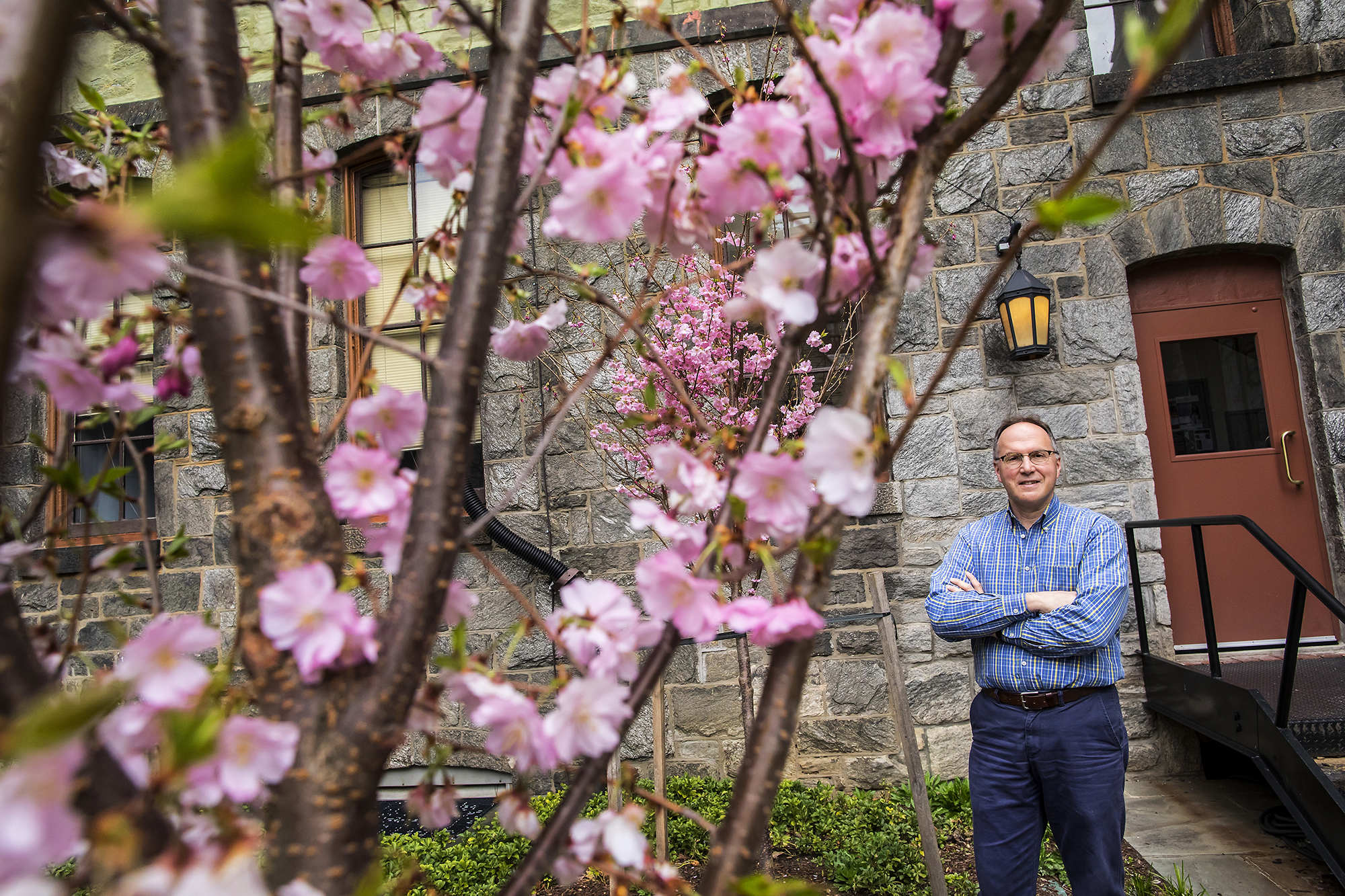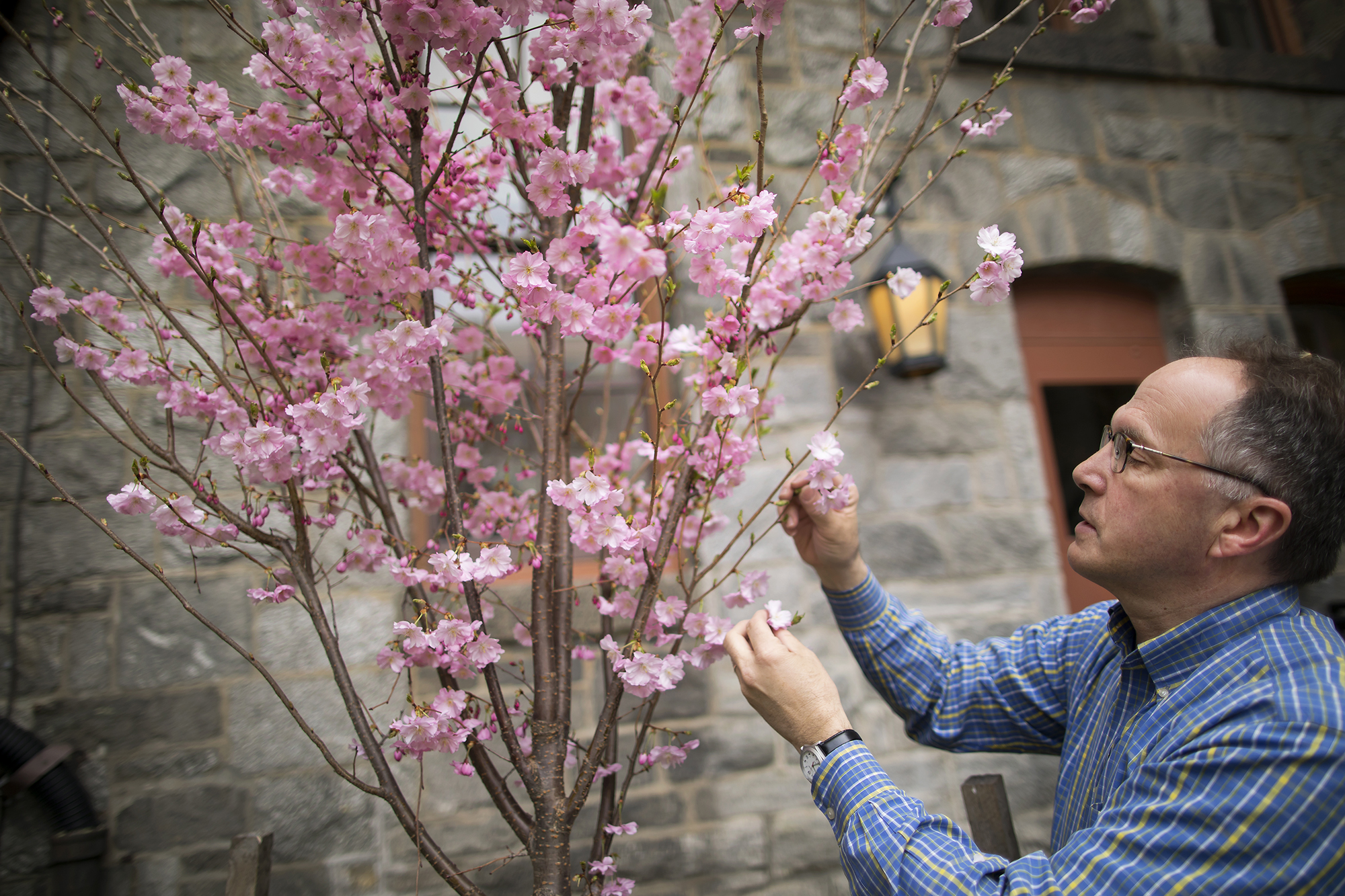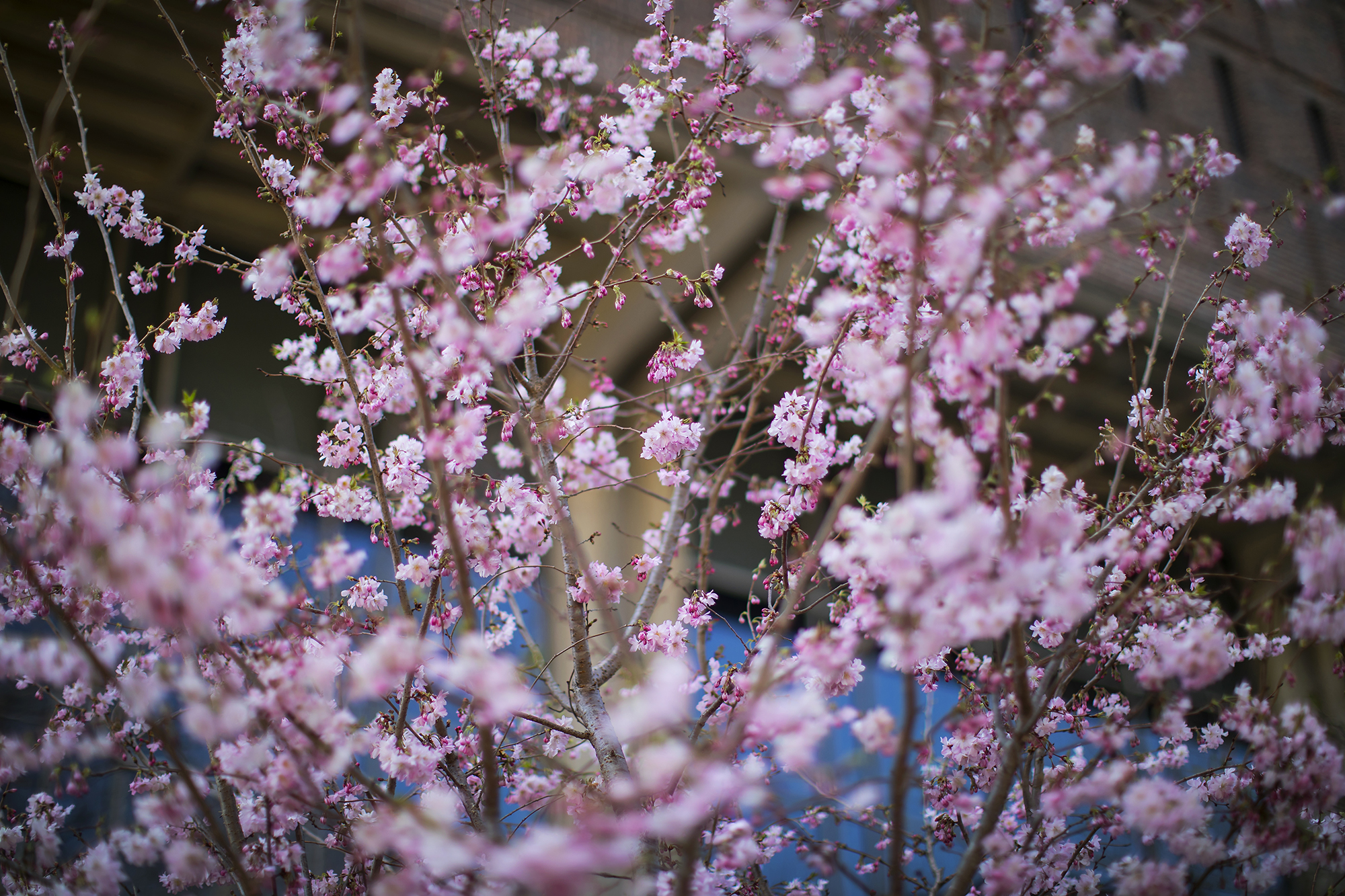
Just as quickly as the cherry trees on campus burst with pink, the ground is blanketed with blossoms—truly, a blink-and-you’ll-miss-it spring delight.
Recognizing as much, Anthony Aiello, director of horticulture and curator at the Morris Arboretum, decided to try to find a way to expand the trees’ season of bloom.
In sum, the challenge is that when the weather warms up very early and suddenly—called a “winter warmup”—the trees are tricked into an early blossom. During some years, he says, this can occur as early as February. But because different varieties have different bloom times and climate tolerance, Aiello endeavored to curate a collection of cherry trees that could withstand varying environments.
Ten years into the project, he’s seeing results—and even expanding the project to Penn’s West Philadelphia campus. Aiello chats with Penn Today about tree-cloning, importing cherry trees, and what’s in store for the Arboretum’s Japanese Cherry Blossom Festival on April 14.

How did you decide to start planting new varieties of cherry trees?
We have a good cherry collection at the Arboretum, and we’ve been doing the Cherry Blossom Festival since probably the early-2000s. I wanted to extend the season, to get some early and later blooms, and just add to what we have to make it more diverse. And since it’s a festival, the focus is to really [lengthen] the season of bloom and increase the diversity.
Around 10 years ago, I started this effort with another arboretum, Longwood Gardens, and the Scott Arboretum in the Delaware Valley, and gardens in New York, Brooklyn, and Washington, D.C., to start to propagate some of the early- and late-blooming trees. I visit them in April and then in June take cuttings, or little pieces of branch that are maybe four or five inches, and take them to a propagation facility we have. [It’s similar to how] you would stick something in a glass of water in your kitchen to get it to root. We have a sophisticated system and can basically clone them. It sounds high-tech, but with plants it’s actually pretty easy. People have been cloning plants for centuries, if not millennia. Plants are easy to reproduce. Think about if you have a houseplant: Stick it in water and it sends out roots; you’re basically cloning that houseplant.
You can do the same thing with flowering cherries.
Why wouldn’t you just use a seed?
To get the same exact cherry, you need to clone it, essentially. Like Barbra Streisand and her dog. [Laughs] To get this exact cherry, you need to take a piece of it and reproduce it. If you take seed from it, it will have a mother and a father; [one tree] will be the mother and it will be like having kids. They’ll be different.
There have been specific varieties selected for [reproduction]. One is called Accolade. It’s located on the south side of College Hall. It’s very bright with big flowers, and it’s a bright pink. So if you want Accolade, you want this variety, the way to do that is to clone it or take cuttings as opposed to seed. If I take seed off this, another cherry nearby might be the father and you’d get all kinds of different [varieties]. The seedlings would have a lot of variation and it wouldn’t be the exact thing. A lot of the flowering cherries you see have been selected or bred for very specific traits.
What I started doing was visiting all these other gardens to look at the varieties they had. And some—this sort of evolved— of those gardens had unique varieties, maybe only represented by one or two plants in the U.S. Sometimes one plant of one variety in the U.S.
Where do these cherry trees come from?
Most of them originally all came from Japan. A lot were brought in during the early 1900s, pre-World War I, but definitely pre-World War II, and people have been growing them in botanic gardens. It’s another type of plant conservation. We think about wild plants, having to conserve wild plants that are endangered, but in the world of horticulture, botanic gardens also preserve horticultural varieties that are rare.
This project evolved from me wanting to expand the season of bloom at the Arboretum, to preserving these rare varieties in botanic gardens. Propagating them, adding them to our collection, and then distributing back to those gardens and other places.
And you’re sending some of these rare cherry trees to campus, right?
We’ve been providing them with rare plants for the last four or five years. Penn’s campus is now an accredited arboretum, and they’ve really wanted to increase their diversity here. And there are a lot of cherries on campus. In the first half of April, it’s pretty remarkable. The number of flowering cherries, it’s beautiful, astounding. The folks who manage the landscape on campus, Bob Lundgren and Chloe Cerwinka, are interested in, one, making it an arboretum, and, two, diversifying what they have on campus. We are not only growing flowering cherries at the Arboretum—that’s what we do—but also growing all kinds of rare and unusual plants. And it’s a little warmer on campus, so we thought Penn’s campus could be a test site. It’s probably, on any given day, five degrees warmer here in the winter, and in summer it’s maybe more—sometimes 10 degrees. There’s a microclimate difference between the two places, so it’d be a good place to test all the things we have up at the Arboretum and then just to get some diversity on campus as well.
The flowering cherries are part of this bigger collaboration between Morris Arboretum and the campus arboretum.
How many cherry varieties are here on campus?
There are probably about 150 flowering cherry trees in total, and probably around 20-25 types. Somewhere along those lines. At the Morris Arboretum, we have approximately 75 varieties or types of flowering cherries.
Have you been successful with extending the season?
I have! The problem with flowering cherries is they’re really unpredictable. In a warm winter, they can flower really early; they’re notoriously unpredictable. Even in Washington, D.C., they never know. They set their festival day, but don’t know if they’ll have any in flower. We have some success at the Arboretum; some earlier ones, some later ones. And then, overall, we’ve increased diversity across the board.
It’s been an interesting project.
Any plans to broaden this?
Yes, is the short answer. I’ve been working with maybe half a dozen botanic gardens and arboreta in the Mid-Atlantic and there’s a few more pretty rare trees we still want to propagate and get back to them. I think once we have a couple more years of that, that phase will wrap up.
We’ve also been working with the USDA and National Arboretum to import varieties. There’s a really good collection in England from a private collector. That collector has a remarkable collection. I’ve been working with the U.S. National Arboretum, a person named Chris Lane in southern England, and [we’re] working to import a number of varieties not in the U.S. The challenge is that cherries are difficult to import because it’s such a difficult economic crop that they get quarantined in Beltsville, [Maryland], outside of Washington, D.C., and they get grown there and quarantined and tested for diseases—your government dollars at work. That gets done and it takes anywhere from five to seven years before they release them. I’ve been doing this since 2011 or 2013 and we’re hoping this year we’ll start to see some of the first ones released from quarantine.
Not so simple a process?
Once they’re in the U.S., you can share them, but bringing them in from outside the U.S. is restricted. That’s why you have to go through this whole quarantine process. It’s fascinating the government does this, for one, and it also requires a lot of patience. I’d love to see these things. I’ve been working on this importation for at least five years now and I haven’t seen the plants yet. That’s obviously a really long-term project.
What do you have planned for the Cherry Blossom Festival?
There are some great events on the two days of our festival. There are all kinds of family events—tours of the collection, interpretations of Japanese culture and our collection. It’s a great thing to bring the family to and everybody loves to enjoy flowering cherries.
For any individual type, the duration of bloom, at most, is two weeks, so they’re very ephemeral. Which is why, in Japan, they’re very revered. They’re beautiful but ephemeral, so they represent life. You have this flowering of your own life and then it fades and doesn’t last; we are all mortal. In Japanese culture, they represent the mortality of humans. It’s a huge part of Japanese culture.
And there are a lot on campus, so you can enjoy them here on campus, too.








